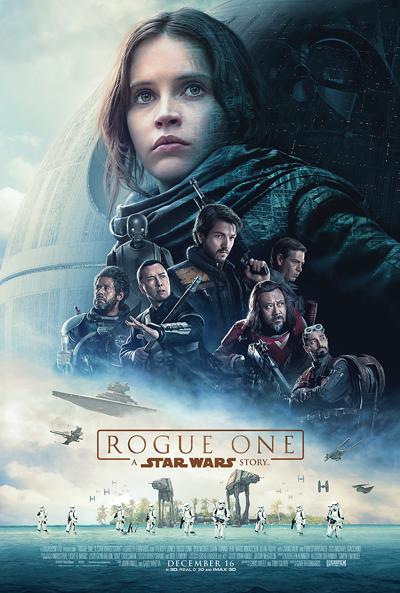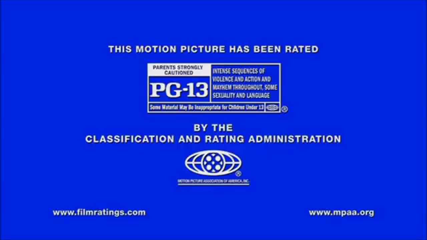
A long time ago, in a galaxy far, far away, a Space Western trilogy took this little blue marble by storm. More than a decade after the original “Star Wars” movies (Episodes IV – VI) bowed out of theaters, out came a threesome of somewhat lackluster–but stunningly visualized–prequels (Episodes I – III). Last year saw the release of an uneven Episode VII, the lead-off for a third trilogy in the series. “Rogue One: A Star Wars Story” fits neatly in between Episodes III and IV, finally giving the details of how the plans for the Empire’s Deathstar landed the hands of the Rebellion.
While firmly planted in the “Star Wars” ‘verse, and hewing so closely to canon as to employ more than a few easter eggs (including of the human variety), “Rogue One” definitely shows it’s not your typical “Star Wars” flick. It dispenses with the traditional opening crawl and dramatic John Williams score, setting the tone from the first second as something that wants to establish its own path rather than reheating material. This is a nice contrast to Episode VII, which got a lot of mileage out of ground well-traveled in Episode IV. The story centers on Jyn Erso (Felicity Jones), the daughter of Imperial prisoner and weapons architect extraordinaire Galen Erso (Mads Mikkelson). Galen manages to save Jyn from immediate capture by the Empire, and she spends some of her formative years in the hands of an estranged Rebellion leader, Saw Gerrera (Forrest Whittaker).
The fully-grown Jyn eventually finds her way into the hands of the Rebellion proper–and they offer her a mission that could lead to her father. She’s paired off with the dashing yet surly Captain Cassian Andor (Diego Luna) and his reprogrammed Imperial droid, K-2SO (Alan Tudyk). The Rebellion is convinced Gerrera has confidential information they need, in the head of an Imperial pilot, Bodhi Rook (Riz Ahmed), who defected and headed straight for Gerrera. It’s at this point where it’s actually wiser to stop providing more detail, because the level of spoilers goes through the roof. It is safe to say that Jyn and Cassian cross paths and take into their confidence two mysterious figures: the blind, Jedi-esque Chirrut Îmwe (Donnie Yen) and Baze Malbus (Wen Jiang), a former protector of a Jedi temple.
No longer on her own, Jyn acquires more than a mission–she gains a rag-tag family of rebels that give her a reason to fight for something bigger than herself. This is a common thread for the “Star Wars” movies, with some of the lines in Chris Weitz and Tony Gilroy’s script resonating just a little too much these days–such as the reminder that “rebellions are built on hope”.
“Rogue One” is a splendid addition to the “Star Wars” legacy, with only a few hiccups here and there. Jyn follows the excellent example set by Daisy Ridley’s Rey in Episode VII, “The Force Awakens”; we’re seeing a whole new level of feminist idols emerging–badass “don’t call me a babe” types who can hold their own in a firefight. It’s pretty fantastic. Weitz and Gilroy simplified the droid sidekick trope by giving K-2SO a coat of sheer smarm handled to perfection by Tudyk. Yen and Jiang are steadfastly brilliant, and Mikkelson performs just the right mixture of stoic and emotional (and finally in a role where he’s not a straight-up baddie–a nice change of pace).
Where “Rogue One” had more opportunities comes in the depth of some of the storylines that somehow got left on the cutting room floor (such as the rallying speech given by Gerrera, heard only in a trailer). Additionally, there seems to be a baked-in expectation that viewers will have spent their spare time catching up on all the canon fleshed out in the “Clone Wars” animated series to be fully oriented in the basic who’s who.
Luna’s performance, while quite easy on the eyes, is a bit more spotty than I would’ve liked, and it feels like some space on that same cutting room floor is littered with character development along the way for Jyn and Cassian, in particular. The level of planet-and-moon-hopping also wears a bit thin; yes, it’s clear that there’s a lot of galaxy to go around, but we didn’t need to fill our Imperial passport entirely in the span of 135 minutes.
For those wonder if it’s worth seeing “Rogue One” in 3D or 3D IMAX, I can say that the 3D is fairly good for giving depth throughout, but the IMAX really only shines during the final act. It’s not necessarily worth springing for IMAX unless that’s your preferred mode.
What about the younglings? Is “Rogue One” okay for kids? This is the third “Star Wars” movie to earn a PG-13 rating, and it definitely has its fair share of action and violence. That said, I found “Rogue One” less startlingly bloody than “The Force Awakens”, so little ones turned off by Episode VII may warm up to this film. Even so, kids younger than 7-9 years old may not be quite ready for all of it (and the 3D IMAX may just overwhelm them). They may do better with one of the 2D showings.
As “Star Wars” movies go, “Rogue One” finally succeeds where all three of the prequels failed miserably. It pairs decent acting with really good dialogue, and it deftly avoids any of the whiny teenager action displayed by the Skywalker brood. This is a “Star Wars” movie worth watching again and again, preferably as a lead-in to a re-watch of Episode IV. “Rogue One” offers hope tinged with painful realism, building on a decades-old legacy in a way that makes it an instant classic.
Three and a half out of four stars.
“Rogue One: A Star Wars Story” opens in theatres on Friday, December 16, 2016. It’s rated PG-13 for extended sequences of sci-fi violence and action.


